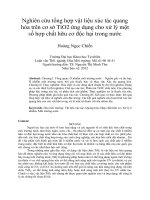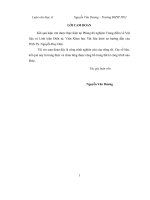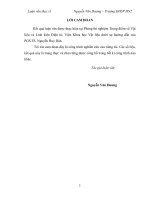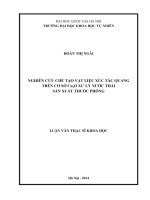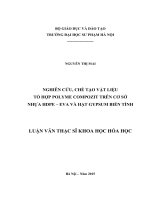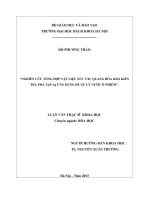Nghiên cứu chế tạo vật liệu xúc tác điện hóa trên cơ sở iro2 cho phản ứng thoát oxy áp dụng trong điện phân nước sử dụng màng trao đổi proton tt tiếng anh
Bạn đang xem bản rút gọn của tài liệu. Xem và tải ngay bản đầy đủ của tài liệu tại đây (1.59 MB, 26 trang )
MINISTRY OF EDUCATION
AND TRAINING
VIETNAM ACADEMY OF
SCIENCE AND TECHNOLOGY
GRADUATE UNIVERSITY SCIENCE AND TECHNOLOGY
------------------------------
Pham Hong Hanh
STUDY AND FABRICATED ELECTROCATALYSTS ON
THE IrO2 BASIS FOR OXYGEN EVOLUTION REACTION
IN PROTON EXCHANGE MEMBRANE WATER
ELECTROLYZER
Major: Theoretical and Physical Chemistry
Code: 9.44.01.19
SUMMARY OF CHEMICAL DOCTORAL THESIS
Ha Noi – 2019
The work was completed at : Graduate University Science and
Technology – Vietnam Academy of Sicence and Technology
Science instructor: Doc. Nguyen Ngoc Phong
Doc. Le Ba Thang
Reviewer 1:
Reviewer 2:
Reviewer 3:
The thesis will be protected before the doctoral dissertation thesis,
meeting at the Academy of Science and Technology - Vietnam
Academy of Science and Technology at ... hour ... ', date ... month ...
2019
The thesis can be found at:
- Library of the Academy of Science and Technology
- National Library of Vietnam
1
PREFACE
1. Urgency of the thesis
Population growth and rapid industrialization of countries,
especially emerging countries such as China and India, lead to rapid
demand for energy worldwide. Currently, more than 80% of energy
needs are met from fossil fuel sources such as oil, coal and natural gas
because they are available in nature, easily and conveniently in transport
and storage. However, fossil fuel sources are gradually exhausted while
increasing demand for energy use has been and will threaten the energy
security of many countries as well as bring to the seed of one. On the
other hand, the use of fossil fuels also creates gas products that pollute
the environment. Therefore, the need to develop new and alternative
energy sources, capable of regenerating and not polluting the
environment is becoming urgent for humankind. Hydrogen is one of the
potential new energy sources in the future, hydrogen is the most
abundant element, its combustion efficiency is higher than petroleum
(60% versus 25%). When burning hydrogen, there is only one byproduct, water, without any waste that is harmful to the environment. In
short, hydrogen is the cleanest, most efficient and endless source of
renewable energy. So hydrogen-based economics will gradually replace
the oil economy and will be the most ideal sustainable economy of
mankind.
There are many ways to produce hydrogen, the proton exchange
membrane water electrolysis method (PEMWE) using uses electricity to
split the pure water into hydrogen at cathode and oxygen at anode. It is a
method with many outstanding advantages: high efficiency (possibly
more than 90%), high purity (about 99%), safe, low energy
consumption, can operate with high current density (up to 2 A.cm-2) and
1
ability to combine with renewable energy sources such as wind power,
solar energy…There are a lot of intensive researches and developments
which have been done on PEMWE and commercialized product s(with
hydrogen production capacity of 0,01‒50000 Nm3.h-1) were provided by
globe companies. However, high cost of investment to use precious and
expensive catalysts material has limited their mass commercialization.
In addiction, the overpotential loss on anode of PEMWE for oxygen
evolution reaction (OER) is still relatively high and this reduce the
efficiency of water electrolysis processes. Therefore, in recent PEMWEs
research have been focused on new catalysts material in order to
improve the anode active surface area, catalyst utilization, and stability
by use nanosize powder materials, thereby improving the performance
and capacity of PEMWE.
In Vietnam, studies of hydrogen production electrolysis using
proton exchange membranes have not been given much attention. In
order to continue gradually with the hydrogen economy and keep up
with the research trend of catalytic materials for PEMWE. Stemming
from that reason, the thesis is aimed at: “Study and fabbricated
electrocatalysts on the IrO2 basis for oxygen evolution reaction in
proton exchange membrane water electrolyser”.
2. Scope of thesis
Fabbrication of electrocatalyst materials on the IrO2 basis for
oxygen evolution reaction in proton exchange membrane water
electrolyser PEMWE.
Applying to fabbricated proton exchange membrane water
electrolyser PEMWE to produce hydrogen.
2
3. Main contents of thesis
- Introduction of proton exchange membrane water electrolyser
(PEMWE), research and development of catalytic materials in PEMWE
based on IrO2: unary, binary and ternary system.
- Introduction of preparation IrO2 powder catalyst by hydrolysis anh
Adams method, the effect of temperature on the characteristics of
synthetic catalyst materials, from which to choose the method and
making the suitable process to sythesis catalyst IrO2.
- Stydy on sythesis IrxRu(1-x)O2 (x =0; 0,5; 0,6; 0,7; 0,8; 1) binary
mixture powder. Evaluation and comparison of the effect of component
ratio RuO2: IrO2 to the activity and durability of catalytic materials.
Select the optimal component with high activity and durability.
- Research and development of IrRuMO2 ternary catalyst (with M = Ti,
Sn and Co).
- Applying to fabbricated proton exchange membrane water electrolyser
PEMWE with 5 cm2 working area including parts: current collector,
separator plate, membrane electrode assembly, shell plate...to produce
high-capacity hydrogen. Test and evaluate the performance of single
PEMWE when operating.
CHAPTER 1. INTRODUCTION
- Introduction of development history, structure, operational principles
and application of PEMWE.
- Present the mechanisms and kinetics of oxygen evolution reaction and
hydrogen evolution reaction on the catalytic materials based on IrO2 in
PEMWE.
- Introduction of development history of catalytic materials used in
PEMWE and research & development of catalytic materials at the anode
and cathode electrodes of PEMWE.
3
CHAPTER 2. EXPERIMENTAL AND RESEARCH METHOD
2.3. Fabrication of electrocatalyst materials on the IrO2 basis
Three methods applied to catalyst synthesis are hydrolysis, Adams and
Adams modified method.
- Hydrolysis method: At first, metal precursors were dissolved in
deionization water with the exactly calculated metal precursors. The
aqueous solution was then heated (100°C) under air atmosphere and
magnetically stirred for 1 hour. Afterward, sodium hydroxide (1 M) was
added to the solution in order to obtain the precursor- hydroxide. This
mixture was maintained under stirring and heat (100°C) for 45 minutes.
The given precipitate was then filtered and washed with deionization
water. After washing the precursor-hydroxide was dried for 5 hours at
80°C. Finally, the dryed paste was calcined in air at 450°C for 1 hour
with a heating ramp of 5°C.min-1.
- Adams method: metal precursors were added to isopropanol to obtain
a total metal concentration of 0.01 M, this solution was ultrasonic for 30
minutes and magnetically stirred for 1-2 hours to ensure complete
dissolution of the precursors, followed by the addition of 10 gram of
finely ground NaNO3. The mixture was heated at 70oC in air until
completely dry. Using isopropanol as the precursor solvent appeared to
give a more homogenous mixture than if water was used. The dry salt
mixture was then placed into a preheated furnace. The fused salt oxide
mixture was cooled slowly to room temperature then washed in
deionised water to remove the remaining salts, filtered and dried in an
oven at 80oC.
- Modified Adams method: the steps are the same as the Adams method
differs only at the furnace stage: before heating at 500°C for 1 hour the
4
salt mixture need pre-heated at 325°C for 30 minutes at a rate of
5°C.min-1.
2.4. Physical and electrochemical cheracterization of electrocatalyst
2.4.1. Physical cheracterization
The mechanisms of the thermal decomposition process of metal
precursors to form oxide powders were studied by means of thermal
gravity analysis (TGA). The physical phase and structure of the oxide
powder catalysts were determined by x-ray diffraction (XRD). The
surface morphology and particle size of the catalysts materials was
examined by scanning electron microscopy (SEM) and transmission
electron microscopy (TEM). Energy-dispersive X-ray spectroscopy
(EDX) is used to determine the composition of the catalyst mixture.
2.4.2. Electrochemical cheracterization
Catalytic layers preparations: The catalyst layer deposited on
the carbon paper (AvCarrb 1071-USA) and the anode electrocatalyst
loading was 4 mg.cm-2; the cathode electrocatalyst loading was 1
mg.cm-2. To prepare the thin-film electrocatalyst layers, a homogeneous
ink composed of powder catalyst, Nafion solution, isopropanol and
deionised water were homogenized by stirring and ultrasonicing. The
mixture was cast on a cacbon paper surface by sweep method and dried
in air, this process was repeated until enough the loading.
CV
measurements
are
measured
with three
purposes:
determination of catalytic activation and electrochemical processes on
catalytic
surfaces:
examine
the
reversibility
of
the
redox process; determination of catalystic degradation.
The anodic polarization curve is carried out by scanning the
linear potential over time with a constant speed of 0.5 mV.s-1 from
-
250 VAg/AgCl to 1.3 VAg/AgCl (compared to the corrosion potential) in 0.5
5
M H2SO4. This method allows the determination of the steady-state
current density, the starting potential of OER.
Galvanostatic: the catalytic samples were polarized at high
current density (200 mA.cm-2) in 0.5 M H2SO4 medium to accelerate the
dissolution or inactivation process of anode, thereby quickly assessing
elctrode’s lifetime. The voltage is recorded over time, the lifetime of the
electrode is the measured time until the electrode is destroyed.
2.5. Fabrication and cheracterization of MEA
Membrane electrode assembly is fabricated by heat-press
method, pressing Nafion film between two diffusion gas layers covered
by catalytic ink. The catalytic layer is fabricated by brushing on the
cacbon paper surface and dried in air. This process was repeated until
reaching enough the electrocatalyst loading of 4mg.cm-2.
In this thesis, a simple PEMWE electrolyte is designed,
manufactured and installed. Materials and specifications of PEMWE are
given in Table 2.5.
Table 2.5. Materials and specifications of PEMWE
Component Material
Size (mm)
MEA
Gasket
Separator
plate
Shell
Current
collector
Bolt
Made in section 2.5.1
Silicon
23 × 23
50 × 50 × 1
Graphite AXF- 5Q (Poco)
50 × 50 × 3,2
Acrylic
50 × 50 × 8
Gold plated copper
50 × 50 × 1
Stainless steel plastic wrap
⏀5
6
CHAPTER 3. RESULTS AND DISCUSSUIONS
3.1. Fabrication of IrO2 electrocatalyst
Fig. 3.1. TGA and DTA diagram
Fig. 3.2. TGA and DTA
of (H2IrCl6.xH2O + NaOH)
diagrams of (H2IrCl6.nH2O +
precursor mixture follows
NaNO3) precursor mixture
hydrolysis method
follows Adams method
Observed on both TGA graphs of the two synthetic methods are
divided into two stages, the first stage occurs at low temperature, salt
mixtures of both methods have a rapid weight reduction. Currently, it is
mainly due to the evaporation of water molecules which adsorb physics
and in the form of hydrate in Ir's salt. The second stage on the DTA and
TGA is the complete thermal decomposition of the salts forming IrO2
powder. For hydrolysis method, this process occurs in the temperature
range of 300-394oC. For Adams method, the decomposition temperature
to create IrO2 powder in the range of 350-605.6oC. The result obtained
by spectra of X-ray diffraction spectra have proved that the final product
is IrO2 (Figure 3.3 and 3.4). From here, IrO2 catalysts will be furnaced at
300oC, 400oC, 500oC and 600oC follow hydrolysis method and 400oC,
500oC and 600oC follow Adams method.
7
Fig. 3.3. XRD patterns of IrO2
fabricated hydrolysis method
Fig. 3.4. XRD patterns of IrO2
fabricated Adams method
Figure 3.3 and 3.4 are X-ray diffraction pattern of IrO2 powder
samples synthesized by hydrolysis and Adams methods at different
furnacing temperatures. At the furnace temperature values lower than
500oC, the peaks on the X-ray diffraction pattern of both synthesized
methods have an unclear peak signal and narrower. This is because the
IrO2 formed at these furnacing temperatures has a very fine structure or
anatas structure. When the furnacing temperature is increased to 500°C
and 600°C, the size of the peaks is smaller and the more peak signals
that represent the crystal structure. The peaks on the X-ray diffraction
pattern have signal peaks at 2θ angle values: 28(110); 35.1(101);
54.3(211) are similar and all peaks match a rutile-structure as indexed.
Thus, at the furnacing temperature of 500oC or more, the IrO2 catalytic
material changes from amorphous structure to rutil crystal structure.
Fig. 3.5. SEM pictures of IrO2 electrocatalytic powers by hydrolysis
method, degree of magnification 80.000 times
8
In order to determine the morphology of the powders, FE-SEM
analysis was carried out on the catalyst oxide powders that synthesized
by hydrolysis (Fig. 3.5). All powder samples are small and uniform in
size and shows the presence of agglomerates composed of fine particles.
While increasing the furnace temperature, particle size of IrO2 catalyst
was increased. This evidence was in agreement with the X-ray
diffraction pattern.
Hình 3.6. TEM pictures of IrO2 electrocatalytic powers by Adams
method, degree of magnification 80.000 times
TEM images of IrO2 samples synthesized by Adams method at
different furnace temperatures in Figure 3.6 show that, compared to the
hydrolysis method, Adams method gives more uniform distribution of
catalyst powders and much smaller size (only a few nanometers). At
400oC, the catalytic particles were very small and there was no clear
grain boundary. This may be because the catalytic powder obtained at
this temperature has an amorphous structure. When the temperature
increased to 500oC, the particles were formed clearly and relatively
evenly. At 600oC, catalyst flour appears with more rod-shaped particles,
which may be due to the faster growth rate of germ growth, making the
crystal size increase.
9
(a) Hydrolysis
(b) Adams
Fig. 3.7. Cyclic voltammograms of IrO2 powders in solution of 0.5
M H2SO4; scanning potential velocity 50 mV.s-1
Fig. 3.7 is the CV graph of the IrO2 catalytic samples
synthesized at different temperatures by two methods of hydrolysis and
Adams. In general, CV curves have a similar standard shape of IrO2.
However, the oxidation-reduction peaks are not clear except the CV
curve of IrO2 furnaced 400oC according to Adams method. In both
methods, the CV of the furnaced at 400oC has the largest area compared
to the furnaced samples at higher temperatures in the same synthesis
method, this is due to irO2 heating at 400oC with an anatas structure,
particle size is the smallest and smoothest so their electrochemical
activity surface is the largest so the catalytic activity is the largest
compared to other samples of the same method. Because the particle
size is much smaller, the IrO2 sample furnaced at 400oC by Adam
method has a larger catalytic activity than the synthetic sample by
hydrolysis method. The higher the temperature, the lower the CV area
means, the lower the activation rate, however the samples synthesized
by the Adams method still have greater activation than the sample of
hydrolysis method at the same temperature.
From the anode polarization curves of the catalytic powders, the
electrochemical parameters were calculated and summarized in Table
10
3.1. Based on the data in Table 3.1, it is found that IrO2 oxide is
furnased at 500oC by the Adams method has been catalyzed to OER in
the highest due to the lowest Eoer.
Table 3.1. Electrochemical parameters for IrO2 powders furnaced
different temperatures
io
Eoer
Charge total
Mẫu
(µA/cm2)
(mV)
(C.cm-2.mg-1)
400oC-Hydrolysis
51
1232
26.25
o
500 C-Hydrolysis
50
1253
22.25
600oC-Hydrolysis
33
1262
12.00
o
400 C- Adams
16
1190
30.50
500oC- Adams
12
1220
23.00
o
600 C- Adams
22
1222
13.75
Thus, the catalyst samples synthesized by Adams method have
smaller particle size so they have better catalytic activity, are more
stable and catalyze the oxygen evolution reaction better than the
synthetic catalysts by hydrolysis method. Furnacing temperature also
greatly affects the structure, activity and durability of the catalyst, at a
furnace temperature of 400oC, the catalysts have a smaller size, better
catalytic activity but less stable more than c furnaced samples at
temperatures of 500oC and 600oC. Optimal catalytic selection is based
on the best combination of specific characteristics of catalysts such as
activity, durability, good catalytic ability for OER as well as production
costs, and furnace temperature of 500°C is the right temperature to
furnace catalyst powder by Adams method.
In order to further optimize the activity surface of the catalytic
powder, melting temperature of NaNO3 at 308oC, so it should be
maintained at this melting temperature for a while so that the melting
NaNO3 will completely react with H2IrCl6 to form IrO2 with high
performance. Applying this improvement, the IrO2 catalyst was
11
synthesized by the Adams method of improvement according to the
two-step heating process, specifically as follows: furnace at 325oC for
30 minutes with a heating ramp of 5 °C min-1 then raising the furnace
level up to 500oC with a heating ramp of 5°C.min-1 and keep at this
temperature for 1 hour.
X-ray diffraction pattern of two IrO2 samples furnaced in one
step and two step modes have the same intensity and peak peaks are
similar and all peaks match a IrO2 rutile-structure as indexed. This
proves that the samples that burn both of these thermal modes form IrO2
rutile structure. However, the furnaced sample in two thermal steps has
a wider peak footprint meaning that the catalytic particles size obtained
are smaller. TEM images of these samples also show that the two stage
samples has smaller (only a few nanometers in size), more uniform
particles, and large particles almost do not appear.
Table 3.2. Electrochemical parameters for IrO2 powders furnaced two
stage
io
Charge total
Parameter
Eoer (mV)
(µA/cm2)
(C.cm-2.mg-1)
IrO2 500oC
16
1220
23.0
IrO2 325oC‒500oC
22
1220
29.5
CV line shapes of two furnace modes are similar. The two-step
furnaced catalytic powder sample has a more charge total than the onestep furnaced catalyst implies that the sample has a better activation
capacity and the reactions take place on the electrode surface easily and
more advantageous. This proves that the two stage furnacing regime
improves the activation of IrO2 catalytic powder. From here, the
catalysts will be fabricated according to the two step calcination
process, the manufacturing process is shown in Figure 3.14.
12
Fig. 3.14. Process of fabrication of IrO2 powder catalytic material
3.2. Fabrication of IrxRu(1-x)O2 electrocatalyst
From the TGA and DTG diagrams when furnaced salt mixtures
(H2IrCl6.nH2O + NaNO3) and (RuCl3.mH2O + NaNO3) in the air, it is
possible to determine the temperature range of 400-600 oC is the
appropriate temperature range for furnaced of a mixture of salt into
IrxRu(1-x)O2, combined with experimental part 3.1 (proved that the
temperature of 500oC is the optimal temperature to synthesize IrO2) we
give the appropriate temperature to synthesize IrO2, Ir0.9Ru0.1O2,
13
Ir0.8Ru0.2O2, Ir0.7Ru0.3O2, Ir0.6Ru0.4O2, Ir0.5Ru0.5O2 and RuO2 are 500°C
following to the improved Adams method of using are two salts
H2IrCl6.nH2O and RuCl3.mH2O precursors.
Fig. 3.17. XRD patterns of IrxRu(1-x)O2
Fig. 3.17 shows XRD patterns of IrxRu1−xO2 powders. As can be
observed that the diffraction patterns of all samples have well-defined
peaks, narrow pics’ width and rutile structures. Diffusion spectra of pure
ruthenium oxide and pure iridium oxide are distributed in nearly
identical 2θ angles due to their similar structures. The diffraction peaks
of the oxide mixture have both all the diffraction angles of the two pure
oxides, however these peaks slowly toward the peaks of the RuO2 oxide
as the gradual increase of the ruthenium concentration. Which may
indicate that when rutheni was added, a lattice was modificated, the
solid phase was formatted and crystal size increases. The average
crystallite sizes for IrxRu1−xO2 powders were estimated using Scherrer
equation, the results are 2.4 nm and 3.1 nm for IrO2 and RuO2,
respectively. As the crystallization temperature of RuO2 is lower than
that of IrO2, the crystallite size increases when increasing the RuO2
amount in the mixed materials. The Ir0.7Ru0.3O2 catalyst was the highest
14
crystallinity showed that the solid phase was best formed at this molar
ratio.
The result of the EDS analysis of IrxRu1−xO2 powder samples
synthesized at x values different. The results show that for all samples
have presence of the elements Ir, Ru and O2 and the composition
measured is very close to the composition target proving that the
Adams’ method is suitable for synthesis of catalyst mixture with the
desired composition.
TEM measurements were performed to analyze the morphology
and the particles size of the synthesized materials. The morphology for
all the samples contain aggregated particles. The particles present a
cuboid shape and have sizes ranging from 2 to 50 nm. IrO2 had the
smallest particle size (about 2-5 nm) but it was inserted lager cuboid
shape (about 10-40 nm). While the RuO2 particles were more uniform
and larger (10-15 nm). As RuO2 was gradually added, the surface
morphology of the particles gradually changed, the size of the particle
increased slightly (but still smaller than the pure RuO2 particles) and the
quanlity of the lager cuboid shape particles was decreased, in
Ir0.5Ru0.5O2 had a few large cuboid particles. Proving that when added,
Ru interacts with Ir to form a solid solution that flattens lager cuboid
shape particles, making the morphology of mixtrure oxides more
uniform.
The paramaters from the CV plot of IrxRu1−xO2 catalyst mixtures
were listed in Table 3.4. RuO2 oxide has the most activity, IrO2 oxide
has the lowest activity, the oxide mixtures have similar shape and
medium activity and the activation area increases as the ruthenium is
added to the mixture.
15
The activity degradation of the catalyst mixtures were shown
by the reduction in the area of CV curves after 1000th cycles in 0.5 M
H2SO4 at a scanning speed of 50 mV s -1, the results also shown in
Figure 6 and Table 2. Results showed that although IrO2 had lower
reactivity, it was more resistant to RuO2, which is consistent with
previous studies. IrO2 was reduced to 4.6 % activity after 1000th cycles
while RuO2 was reduced to 19.8 %. As RuO2 was gradually added,
activity degradations increased but these increases was insignificant
compared to the large reduction of pure RuO2.
EOER ,io parameters from polarisation (table 3.4). Similar to
previous study, RuO2 is the most active, its corresponding starting
potential of oxygen evolution is the lowest (1100 mV) and the catalytic
properties are optimized and IrO2 is the lowest active. For mixture
oxides, the starting potential of oxygen evolution decreases with the
increase of RuO2. There result are similar to the result of the CV
measurements. This imply that the presence of the ruthenium in the
electrocatalyst and it can be insert the latice to the formation of a
common valence band with iridium oxide, thus promotes the oxygen
evolution reaction. However, RuO2 is also known to be less stable than
IrO2, in the acid media RuO2 can corrode to RuO4 so the corrosion of the
mixture oxides increase with increase of ruthenium content. Thus, a
solid solution with a moderate Ru content on the outercatalyst surface
should represent a good compromise between activity and stability. In
this study, the optimun Ru content is 30 % mol, because at this mol ratio
Ir0.7Ru0.3O2 has the best combination of activity and stability.
16
Table 3.4. Electrochemical parameters of IrxRu1−xO2
io
EOER Charge total
Activity
Catalyst
(µA/cm2) (mV) (C.cm-2.mg-1) degradatio(%)
IrO2
22
1220
29.5
4.6
Ir0.9Ru0.1O2
11
1200
32.8
5.1
Ir0.8Ru0.2O2
14
1180
33.7
6.1
Ir0.7Ru0.3O2
16
1140
38.2
7.8
Ir0.6Ru0.4O2
20
1160
34.6
9.5
Ir0.5Ru0.5O2
24
1150
36.9
10.2
RuO2
42
1100
38.9
19.8
Fig. 3.27. Polarisatiom curves of IrxRu1−xO2 electrocatalytic power in
0.5 molL-1 H2SO4 electrolyte, 1 mV.s-1
Thus, it can be seen that the modified Adams method has
produced IrxRu1−xO2 catalyst mixture with relatively uniform size, small
size of nanometer size and rutile structure, with good activity and
durability for oxygen evolution reaction at anode. The addition of
ruthenium formed a solid solution between Ir and Ru which
significantly improved the surface morphology as well as the size of the
catalytic particles thereby improving the catalytic activity without
significantly reducing the durability for OER. Ir0.7Ru0.3O2 catalyst
mixture has the best crystallization because at this molar ratio the solid
solution formation between Ru and Ir is the highest. Ir0.7Ru0.3O2 particles
have fairly uniform morphology for highest activity and average
17
durability among catalytic mixtures. It can be said that the catalyst
mixture with the molar ratio (Ir: Ru) = (7: 3) shows the best
combination of activation and stability, so we chose the mixture
Ir0.7Ru0.3O2 for further research.
3.3. Fabrication of IrRuMO2 ternary catalyst ( M = Ti, Sn, Co)
Fig. 3.28. XRD patterns of IrRuTiO2; IrRuSnO2; IrRuCoO2.
Purpose of this study insert third component to Ir0.7Ru0.3O2
mixture catalyst to reduce the precious metal to fabricate IrRuMO2
which still keep its activity and durability for OER. Substances insertion
with an initial molar ratio of Ir: Ru: M = 1: 1: 1 (M = Ti; Sn; Co)
Figure 3.29 is X-ray diffraction of IrRuTiO2; IrRuSnO2;
IrRuCoO2 and Ir0.7Ru0.3O2 catalytic powders. It can be seen that the
diffraction spectrum of all 3 mixes has the main peaks of Ir0.7Ru0.3O2.
The peak signal of IrRuTiO2 is most clearly, then IrRuCoO2 and
IrRuSnO2. This proves that the catalyst with M = Ti has the highest
crystal degree. The reason may be that Ti has the same crystal size as Ir
and Ru, so it is easy to mix with Ir and Ru at crystal level to form a solid
solution. The width of the peaks shows that the crystal of IrRuSnO2 is
the smallest, then IrRuCoO2 and IrRuTiO2, that are also consistent with
the TEM image in Figure 3.29.
18
Fig. 3.29. TEM micrographs of IrRuMO2 (M = Ti, Sn, Co),
electrocatalytic, magnification 80.000 times
The values of electrochemical determined from the graphs are
listed in Table 3.5. The activity of catalyst also changed with increasing
activity towards Ti
ρSnO2 = 107 Ωcm; ρCo3O4 = 104 Ωcm). However, The activity
degradation after 1000 scanning cycles of IrRuCoO2 is highest because
Co3O4 is a strong oxidation, so it is not sustainable in acidic
environment which is facilitated by PEMWE.
Thus, considering the catalytic durability, IrO2 is still the ideal
catalyst for OER. The mixture of Ir0.7Ru0.3O2 is the best combination
between the durability of IrO2 and the activation of RuO2. When
replacing Ir and Ru expensive than cheaper element, Ti is a good choice.
To ensure performance and durability when applying an anode catalyst
to a single PEMWE, we decided to select the catalytic mixture of
Ir0.7Ru0.3O2 for further tests.
Table 3.5. Electrochemical parameters of IrRuMO2
io
Eoer
Charge total
Activity
Catalyst
(µA/cm2)
(mV)
(C.cm-2.mg-1) degradation(%)
Ir0.7Ru0.3O2
16
1140
38.2
7.8
IrRuSnO2
38
1220
33.7
19.4
IrRuTiO2
28
1220
26.7
16.7
IrRuCoO2
49
1138
42.6
18.84
19
3.4. Fabrication and cheracterization of single PEMWE
The components of the single PEMWE are designed to include:
separator plate with water channels, current collector, shell and gasket,
then they are assembled. Figure 3.39 is the image of a single PEMWE
and figure 3.40 is a single PEMWE test system.
Fig. 3.39. Single PEMWE
Fig. 3.40. Single PEMWE system
The energy conversion efficiency of PEMWE is determined by
the properties of MEA. The properties of MEA will be affected by
parameters such as catalytic density, ionomer content and especially the
method of manufacturing MEA. In the hot pressing method used to
make MEA, the pressing process at high temperature plays a very
important role. There are three important parameters in the pressing
process that will affect the properties of MEA: pressure, temperature
and pressing time. In this thesis, the pressing time and temperature are
fixed at 180 s and 130oC, the pressure is changed from 18-22 kg.cm-2.
Figure 3.43 is a V-I graph of a single PEMWE with MEA
pressed at different pressures. Observing on V-I, it is found that when
the pressure decreases, the polarization curves tend to shift to the left,
indicating that the pressure is reduced, the voltage of PEMWE
increases. During the average current density stage, the slope of line V-I
of MEA fabricated at 20 and 22 kg.cm-2 is lower than that of MEA
manufactured at other pressure values, meaning that the internal
20
resistance of MEA is made at pressures of 18 and 24 kg.cm-2will be
higher than the internal resistance of MEA fabricated at pressures of 20
and 22 kg.cm-2. This may be due to the loose cohesion between the
diaphragm and the catalyst layer at the pressure of 18 kg.cm-2, while at
the pressure of 24 kg.cm-2, this cohesion is much more compact as the
results of SEM photo. At the pressure value of 22 kg.cm-2, the potential
of PEMWE is reached at the lowest current density of 1 A.cm-2,
indicating that the performance of this pressure is the highest in
PEMWE.
Figure 3.44 is a potentiometric graph of PEMWE with MEA
made from four different pressures. On the graph, it can be seen that the
voltage curves over time shift to the left in the direction of reducing
pressure. With MEA fabricated at small pressure of 18 kg.cm-2, the
voltage value increases rapidly and has the greatest value. This may be
due to weak pressure so the bonding is not good enough, causing the
separation of the GDL layer with the nafion membrane after a period of
osmosis of the water molecule through the bonding surface. Therefore,
the pressure of 18 kg.cm-2 is not enough to make MEA by heat press
method. At the pressures of 20 and 24 kg.cm-2, there is a relatively good
level of stability even though the voltage is quite high. The potential of
PEMWE with MEA made from pressure 22 kg.cm-2 gives the best
stability at the lowest voltage value and this is also consistent with the
results obtained from the graphs in Figure 3.43 .
21
Fig. 3.43. U-i curve of PEMWE
Fig. 3.44. Durability of PEMWE
with different MEA’s pressure
over time
To evaluate the hydrogen production of the single PEMWE
with MEA pressed at 22 kg.cm-2 was operated at different current
density values. The amount of hydrogen gas is collected in the flask and
measured volume. At the pressure value of 22 kg.cm-2, the potential of
PEMWE at density of 2 A.cm-2, the yield of hydrogen can reach 8.2
ml.min-1.
Table 3.8. Voltage of the PEMWE from reference studies
TT Electrocatalyst
for OER
1
Ir0.6Ru0.4O2
2
IrO2
3
IrO2
4
Ir0.2Ru0.8O2
5
Ir0.7Ru0.3O2
6
Ru0.8Nb0.2O2
7
Ir0.5Ru0.5O2
8
Ru0.9Ir0.1O2
9
Ir
10
Ir0.5Ru0.5O2
Potential at current density
1 A/cm2 (V)
1.567
1.600
1.610
1.617
1.618
1.620
1.710
1.750
2.000
2250
Reference
[35]
[97]
[49]
[86]
Luận án
[98]
[99]
[100]
[70]
[90]
Table 3.8 provides some research results on the electrolytic
efficiency of a single PEMWE using catalysts for OER, the main
parameter used to evaluate electrolytic efficiency is potential value at
current density 1 A.cm-2. When compared with the results, the potential
22
value of the single PEMWE using catalyst Ir0.7Ru0.3O2 achieved 1.618 V
in this thesis is quite low, indicating the catalytic Ir0.7Ru0.3O2 and the
single PEMWE is highly effective.
CONCLUSIONS
1. The IrO2 oxide powder catalysts for oxygen evolution reaction in
proton exchange membrane water electrolyser were synthesized by
Adams method using H2IrCl6 precursor.
2. The Adams method has been improved and the modified Adams
process has been stabilized to produce 1 gram IrO2 catalyst material
with rutile crystal structure, nano-size particle (3-20 nm), active, durable
for OER in 0.5 M H2SO4 solution.
3. The IrxRu(1-x)O2 (x =0; 0,5; 0,6; 0,7; 0,8; 1) were synthesized by
modified Adams method. Finding the molar ratio Ir: Ru is 7: 3,
providing the best combination of activity and durability of the catalyst.
It is a catalytic mixture Ir0.7Ru0.3O2.
4. The IrRuMO2 (M = Ti; Sn; Co) were synthesized. The research
results indicate that the third element is Titan has activity and durability.
The application of IrRuTiO2 catalyst in PEMWE promises to bring
economic efficiency by reducing the cost of using iridium precious.
5. A single PEMWE with a 5 cm2 working area has been designed and
manufactured in the laboratory with self-synthetic Ir0.7Ru0.3O2 catalyst.
The suitable technical parameters for manufacturing MEA used hot
pressing method were pressure: 22kg.cm-2, temperature: 130oC, time:
180 s. The potential of single PEMWE was 1.618 V at 1 A.cm-2. This
voltage equivalent to studies in the world.
NEW DISTRIBUTRIONS OF THESIS
1. The IrO2 và IrxRu(1-x)O2 (x = 0; 0.5; 0.6; 0.7; 0.8; 1) electrocatalysts
has been fabricated based on modified Adams process with correction
23
